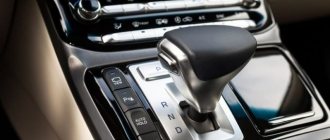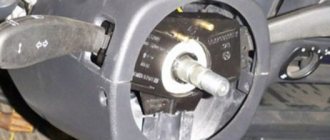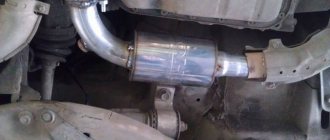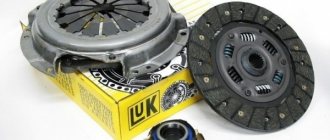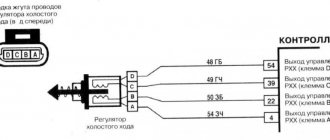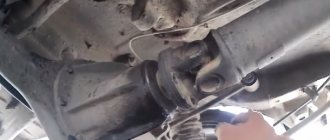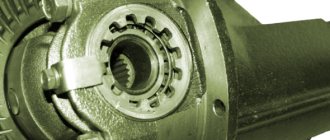Car owners become interested in the issue of gear ratios in two cases. The first one is for reference and characterizes the inquisitive. After all, the more you know about the structure of the car, the longer and more competently it will work. However, most often the gear ratio is determined in case of problems with the gearbox.
Knowing what gear ratio your car has, you can:
- Always correctly replace a faulty gearbox or its parts;
- understand how the car will behave when installing a gearbox with parameters different from the original factory ones.
Definition of the concept
What is the gear ratio? Any gearbox is used to transmit torque from the gearbox to the wheels. In this case, the rotation speed always decreases. The gear ratio is precisely an indicator of how many times this reduction occurs. For example, the number 5.125, found in Gazelle gearboxes, shows that the rotation speed from the input shaft to the wheels is reduced by 5.125 times.
In practice, the gearbox in a car is located on the drive axle. If we are talking about all-wheel drive options, there are two gearboxes, one for each axle. Domestic cars produced by VAZ and GAZ have a rear gearbox, with some exceptions. To determine the gear ratio, you can do this in several ways:
- theoretical;
- practical;
- calculated
Operational coefficient (service factor)
Service factor (Sf) is calculated experimentally. The type of load, daily operating duration, and the number of starts/stops per hour of operation of the gearmotor are taken into account. The operating coefficient can be determined using the data in Table 3.
Table 3. Parameters for calculating the service factor
| Load type | Number of starts/stops, hour | Average duration of operation, days | |||
| <2 | 2-8 | 9-16h | 17-24 | ||
| Soft start, static operation, medium mass acceleration | <10 | 0,75 | 1 | 1,25 | 1,5 |
| 10-50 | 1 | 1,25 | 1,5 | 1,75 | |
| 80-100 | 1,25 | 1,5 | 1,75 | 2 | |
| 100-200 | 1,5 | 1,75 | 2 | 2,2 | |
| Moderate starting load, variable mode, medium mass acceleration | <10 | 1 | 1,25 | 1,5 | 1,75 |
| 10-50 | 1,25 | 1,5 | 1,75 | 2 | |
| 80-100 | 1,5 | 1,75 | 2 | 2,2 | |
| 100-200 | 1,75 | 2 | 2,2 | 2,5 | |
| Operation under heavy loads, alternating mode, large mass acceleration | <10 | 1,25 | 1,5 | 1,75 | 2 |
| 10-50 | 1,5 | 1,75 | 2 | 2,2 | |
| 80-100 | 1,75 | 2 | 2,2 | 2,5 | |
| 100-200 | 2 | 2,2 | 2,5 | 3 | |
Where are the gear ratios written?
The easiest way to find out the gear ratio of the rear axle of a car is to look in the documentation. For many foreign cars this number is encrypted in the Vin number. For domestic cars, there are standard gearboxes for certain models. At the same time, there are cars that can be equipped with a number of gearboxes with different gear ratios.
It is possible to find out information specifically and in detail. There is no need to remove the gearbox for this. If there is information, it is located in a place convenient for inspection.
Practical way to determine
The most accurate way to determine the gear ratio is to count the number of teeth on the drive and driven gears. Then the larger number is divided by the smaller number, which gives the desired result. For example, in the domestic model VAZ-2106, the number of teeth on the drive shaft is 41, and the number of teeth on the differential driven gear is 11. As a result, dividing one number by another, we get: 41: 11 = 3.9.
This method of determination is the most accurate, but at the same time not at all practical. Because for this option it is necessary to disassemble the gearbox and get the necessary parts. And this is not only inconvenient, it is always expensive.
Answers from experts
shelepiha:
There are two gears and they always go in pairs. On 06 11 on the drive and 43 on the driven On 03 10 and 41 teeth On 01 10 and 43 teeth
In general, when the gearbox is removed, turn the driven gear and you will see a strictly stamped marking like this: 10/43 is 01 or 10/41 is 03 or 11/43 is 06
Just Grandfather:
01-41, 03 -38, 06 - 36 BUT this is all approximate! Since there are 063, 065, etc. There is a difference in the gear ratio in both the gearbox and the gearbox.
Eric 29Rus:
Machkin Man:
Depends on what engine and what gearbox
Dmitry Levin:
Rear axle gearboxes on classics differ in gear ratio.
3.9 (43/11) — 21043,21053,2107,21074
4.1 (41/10) — 2101,21011,21013,2103,2104,2105,21053,2107,21072
4.3 (43/10) — 2101,21011,21013,2104,2105,21051,21072
4.44 (40/9) — 2102,2121.
Dimitri:
The smaller the bridge, the faster the bridge will be; the larger the bridge will be for traction!
Calculation method
Is it possible to find out the gear ratio of an unknown car without disassembling the gearbox? It turns out there is such a way. To do this, the axis on which the gearbox is installed is hung on supports. The position of the drive shaft and wheels is remembered. It is convenient to do this with simple marks. Then the wheels are turned until the marks coincide again, counting the number of revolutions of the wheels and shaft separately. It is more convenient to carry out this procedure with an assistant.
After obtaining experimental data, the number should be calculated by dividing the number of shaft revolutions by the number of wheel revolutions. The accuracy of this method is approximate and is improved only by being careful when counting and combining marks.
We install a gearbox with a different gear ratio
What happens if the gearbox being replaced has different parameters from the installed ones? For example, consider the gear ratios of VAZ gearboxes. The line of units is represented by four gearboxes. Their numbers fall in the range from 3.9 to 4.44.
A gearbox with a number of 3.9 will be the fastest of the family, and a gearbox with a number of 4.44 will be the most high-torque. Because in the first case, the power transmitted by the input shaft decreases only 3.9 times versus 4.44. It turns out that if the gearbox transmits torque faster, the car becomes more “nimble”. If you replace the gearbox with a version with a lower gear ratio, the car accelerates more slowly, but becomes more passable and high-torque.
When installing a gearbox with a number different from the factory number, it is imperative to check the speedometer readings. Most often he starts to lie. The problem can be solved by adjustment, and sometimes you have to change the speedometer cable. The most difficult thing when replacing a gearbox is not the removal and installation, as it might seem initially, but the adjustment and configuration. Without proper adjustment, even a properly selected gearbox can become unusable after several thousand miles.
Gear ratios of VAZ gearboxes
Let's take a closer look at the rear gearboxes installed on domestic VAZ cars. As mentioned earlier, there are a total of four gearboxes that were equipped with rear-wheel drive versions of AvtoVAZ. The fastest gearbox belongs to the sixth model of the Zhiguli. The rear axle gearbox of the VAZ-2106 has a gear ratio of 3.9. This figure is obtained from the ratio of the teeth of the input shaft and driven gear of 43:11.
The next fastest gearbox with a number of 4.1 belongs to the VAZ-2103. This unit has average, but also the most balanced indicators, such as acceleration, maximum speed and power. The first VAZ models had the highest torque gearboxes. Thus, the VAZ-2101 had a power transmission device according to the scheme 43: 10 = 4.3, and the VAZ-2102 - 40: 9 = 4.44. Because of this, the second model was the most convenient for driving with a trailer, although it had the lowest maximum speed - 145 km/h.
What gear ratio of the VAZ rear axle gearbox can be considered optimal? Each Zhiguli car owner will decide the answer to this simple question himself. To do this, it is enough to understand for what purposes the car will be used. If this is primarily a workhorse, the best option would be the most powerful gearbox with a 4.3 number. Ideally, of course, to install the “double” option, but the main pairs with the number 4.44 stopped being produced with the cessation of production of the VAZ-2102 a long time ago. For ordinary driving in urban conditions, the best gearbox is from a VAZ-2106 with a number of 3.9.
A few words about the gear ratio of all-wheel drive VAZ-2121 gearboxes. Since there are two gearboxes on such cars, it is important that the number is the same and corresponds to the ratio 41: 10 = 4.1.
Design and principle of operation
What parts does such a responsible mechanism consist of? The classic gearbox design requires the following working parts:
- body part with a cover, a hole for checking the technical fluid level;
- set of bearings;
- shafts - depending on the purpose and number of gears, in addition to the input and output, an intermediate one is added;
- parts that implement transmission between shafts - gears, worm elements.
The layout of the elements depends on the type of gearbox. In addition to the above basic elements, the device consists of additional parts - stuffing box seals, keys, adjusting rings, sealing gaskets.
Device
Gear mechanisms can be single-stage or multi-stage. An example of the simplest gearbox is the meshing of two gears or gears of different diameters, an external type of gearing. The smaller gear is the drive gear, located on the drive shaft of the gearbox. This shaft receives torque from the engine. The large gear is the driven gear and is fixed to the driven shaft. If the difference in the number of teeth between the gears is 3 times, the drive will make one full revolution, and the driven will turn the shaft only a third. The traction force on the driven shaft is 3 times relative to the output force of the engine.
The drive shaft of the gearbox is always slightly smaller than the driven one - this design feature, due to the difference in torque, helps determine its type. The use of elements such as stuffing box seals is necessary to seal the lubricant inside the gearbox housing. Keys secure gears to shafts. Gearbox diagrams are necessary for a complete display of all elements, indicating markings and dimensions.
Interesting: Metal cutting technology with gas
The gears on the shafts are located inside the housing with bearings. Lubrication is achieved by partially or completely filling the housing volume with process oil. The viscosity and composition of oil in industrial and automotive gearboxes are different. When the bath is partially filled (often found on industrial gearboxes), the gear teeth, moving down, capture the oil and thus lubricate the contact zone in the gear. The oil must be replaced: for a gearbox, the schedule is set based on the vehicle’s mileage in kilometers, for an industrial gearbox it depends on the operating time in hours.
Depending on the required gear ratio, the number of stages increases, the elements transmitting torque change. An axle in a passenger car with all-wheel drive is characterized by equal gear ratios in the front and rear mechanisms - to synchronize the rotation of the wheels.
The cover is necessary for access and inspection of the internal structure without completely disassembling the mechanism. Parts are subject to periodic inspection for wear.
Operating principle
The principle of operation of a mechanical gearbox is the interaction of the teeth of the parts that transmit torque. The power unit supplies torque to the drive shaft of the mechanism, the output shaft produces lower speeds and increased torque. If the mechanism is high-speed, then the shaft speed increases and the power torque decreases. The gearbox, as a power link, works to transmit torque to the actuator.
Marking
To designate gearbox models, combinations of letters and numbers are used to characterize the parameters and type of device. In the first place the number of stages and type of transmission are indicated:
- worm - H;
- cylindrical - C;
- globoid – G;
- conical - K;
- planetary – P.
Example of gearbox marking
For combined models, the letter indicating first gear is placed first:
- cylindrical-worm - TsCh;
- conical-cylindrical - CC;
The number of gears of a certain type is indicated by a number placed before the letter of the gear.
Rear gear ratios of other cars
The gearboxes of VAZ cars are more or less clear. What about other cars? For example, the Gorky Automobile Plant has a large number of modern models of both medium-duty and passenger trucks. The most popular GAZ models are the Gazelle GAZ-3302 and Sobol GAZ-2752. If we do not consider all-wheel drive modifications of these cars, then the rear gear ratio will be either 5.125, or 4.556, or 4.3.
The highest-torque gearbox went to GAZ vehicles with ZMZ406 and ZMZ402 engines. It has the best power characteristics and is recommended for car owners transporting heavy loads and working in harsh conditions. A gearbox with a lower number will give greater dynamics, like a faster one. In this case, a relatively shorter service life should be noted.
To complete the picture, let’s consider foreign versions of gearboxes and their numbers. A good option for comparison would be the rear-wheel drive models of the German auto giant BMW. BMW gear ratios range from 3.07 to 4.1. Moreover, the number of unit models exceeds ten. Just from this indicator you can understand how often foreign designers make changes to car components.
The most dynamic gearbox with a number of 3.07 is found in models of the E90, E91 and E92 series. If we look at powerful options, we can highlight the BMW X5 with a 3-liter engine, which has a rear gear ratio of 4.1.
Types of main gear by type of gear connection
If we divide the types of main gears, then we can distinguish:
- cylindrical;
- conical;
- worm;
- hypoid;
Cylindrical final drives are used in front-wheel drive passenger cars with a transverse engine and gearbox. Its gear ratio is in the range of 3.5-4.2.
Spur gears can be spur, helical or chevron. The cylindrical gear has a high efficiency (at least 0.98) but it reduces ground clearance and is quite noisy.
The bevel final drive is used on rear-wheel drive light and medium-duty vehicles with a longitudinal arrangement of the internal combustion engine, where overall dimensions do not matter.
The axes of the gears and the wheels of such a transmission intersect. These gears use straight, oblique or curved (spiral) teeth. Noise reduction is achieved by using an oblique or spiral tooth. The efficiency of the final drive with a spiral tooth reaches 0.97-0.98.
The worm main gear can be either with a lower or an upper worm arrangement. The gear ratio of such a main gear is in the range from 4 to 5.
Compared to other types of gears, the worm gear is more compact and less noisy, but has a low efficiency of 0.9 - 0.92. Currently, it is rarely used due to the complexity of production and the high cost of materials.
Hypoid final drive is one of the popular types of gear connection. This transmission is a kind of compromise between a bevel and a worm final drive.
The transmission is used on rear-wheel drive cars and trucks. The axes of the gears and the wheels of the hypoid gear do not intersect, but are crossed. The transmission itself can be either with a lower or an upper offset.
A bottom offset final drive allows the driveline to be positioned lower. Consequently, the center of gravity of the car also shifts, increasing its stability when driving.
Compared to bevel gears, hypoid gears are smoother, quieter, and smaller in size. It is used on passenger cars with a gear ratio of 3.5-4.5, and on trucks instead of a double main gear with a gear ratio of 5-7. In this case, the efficiency of the hypoid transmission is 0.96-0.97.
With all its advantages, the hypoid transmission has one drawback - the jamming threshold when the car reverses (exceeding the rated speed)
For this reason, the driver must take special care when selecting the speed of reversing.



